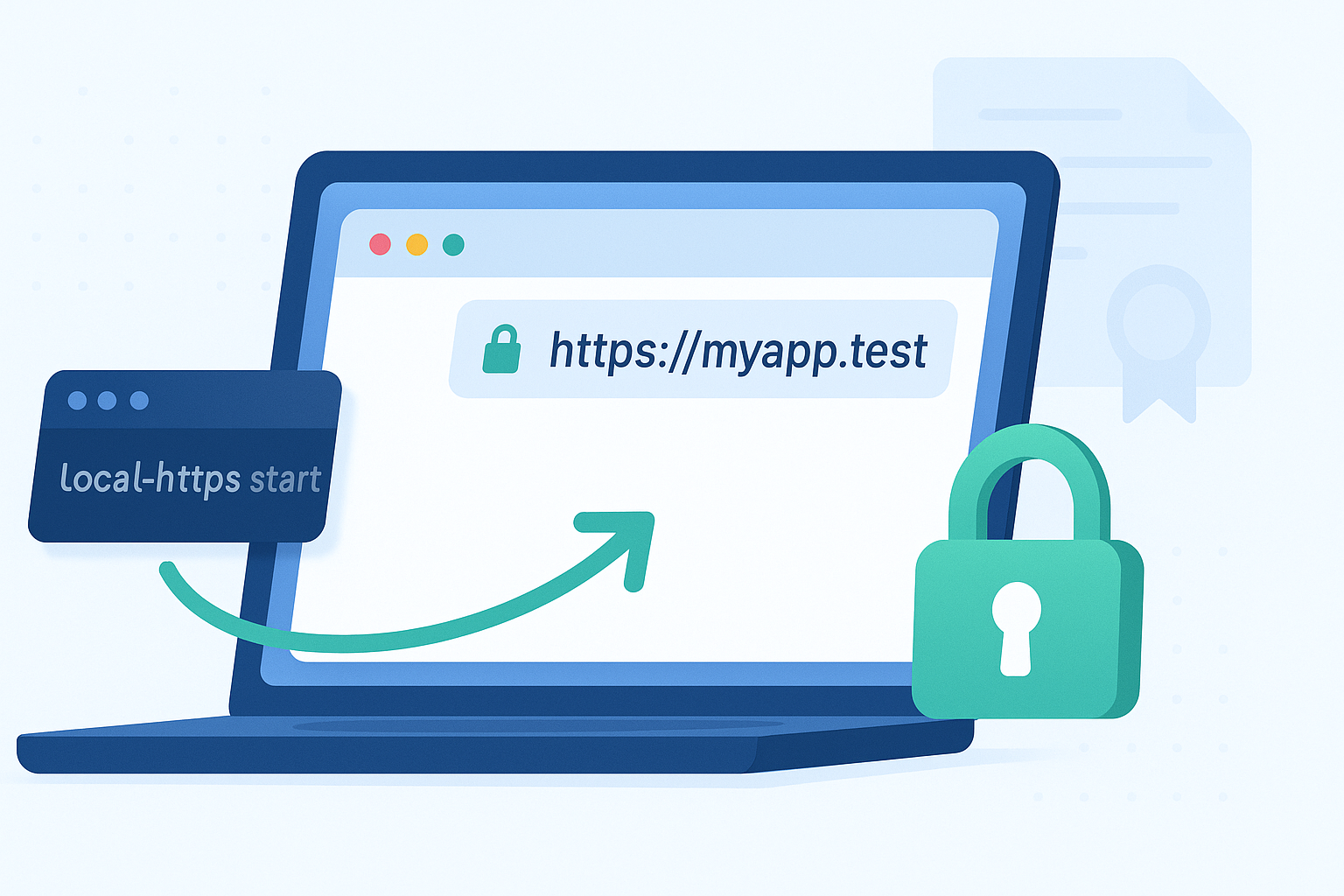Modern browsers expect HTTPS. Cookies with Secure, OAuth callbacks, Service Workers, HTTP/2, and many APIs either require or work better with HTTPS.
I created local-https, a simple tool to run any local project on HTTPS with a custom local domain.
- No browsers hacks
- No changing your app’s code
- Works on macOS and Linux
GitHub: https://github.com/vikas-0/local-https
What is local-https?
local-https is a small Ruby CLI that:
- Generates trusted local TLS certificates with mkcert
- Maps your domain to 127.0.0.1 in
/etc/hosts - Runs an HTTPS reverse proxy (WEBrick) that forwards to your local app
- Supports multiple domains via SNI
- Optionally redirects HTTP (port 80) to HTTPS (port 443)
You get a local URL like https://myapp.test that points to your app on localhost:3000.
Quick start
Requirements:
- macOS or Linux
- Ruby 3.0+
sudoaccess for binding to ports 443/80 and editing/etc/hosts
Install:
Homebrew (Tap):
brew tap vikas-0/tap
brew install vikas-0/tap/local-https
Manual (from source):
git clone https://github.com/vikas-0/local-https
cd local-https
./install.sh
Steps:
# 1) Add a mapping (domain -> local port)
local-https add myapp.test 3000
# 2) Start the proxy (binds to :443 and :80 for redirect)
sudo local-https start
# 3) Open your app
open https://myapp.test
Tips:
- Run in foreground for logs:
sudo local-https start --no-daemon - Disable HTTP→HTTPS redirect:
sudo local-https start --no-redirect-http
Works with any tech stack
As local-https simply terminates TLS and proxies to your local port. It doesn’t require any stack specific configuration.
- Frontend frameworks (Next.js, React, Vue, Vite, Angular)
- Backend APIs (Rails, Django, Flask, Express, Spring)
- Webhooks and OAuth callback testing (GitHub, Google, etc.)
How it works (under the hood)
- Certs are created with mkcert and saved in
~/.local-https/certs /etc/hostsgets127.0.0.1 myapp.test # local-https- The proxy presents the correct certificate per domain (SNI) and forwards traffic to
http://127.0.0.1:<port> - Config is a simple JSON file at
~/.local-https/config.json
Configure your app to accept your custom domain
Most frameworks will just work, but some block unknown hosts in development. Make sure your app accepts the domain you chose (like myapp.test).
Example: Rails (config/environments/development.rb)
# Allow your custom domain in dev (Rails 6+ Host Authorization)
config.hosts << "myapp.test"
# Optional: if you generate URLs in controllers/mailers, set defaults
config.action_controller.default_url_options = { host: "myapp.test", protocol: "https" }
config.action_mailer.default_url_options = { host: "myapp.test", protocol: "https" }
# You do NOT need to force SSL in Rails dev. local-https terminates TLS and
# forwards plain HTTP to your app on localhost:PORT.
# config.force_ssl = false
Notes:
- If you use multiple local domains, add each one with
config.hosts << "api.test". - For subdomains, you can whitelist a regex:
config.hosts << /.*\.test/. - Keep your app listening on its normal dev port (e.g., 3000); no TLS changes needed in the app.
Why HTTPS locally?
- Secure cookies, SameSite=None, Service Workers
- OAuth callbacks and cross-origin requests
- Matching production behavior
- Avoid mixed content warnings and browser feature limits
Frequently asked questions (FAQ)
Can I use multiple domains?
- Yes. Add as many as you want:
local-https add api.test 4000, etc.
- Yes. Add as many as you want:
Do I need to change my app code?
- No. Your app still listens on HTTP (localhost). The proxy handles HTTPS.
Does this work with Docker?
- Yes. Point the mapping port to the host port where Docker publishes your service.
Is this safe?
- Certificates and config live in your user home. The proxy only listens locally (by default bind
0.0.0.0, changeable in code). For public exposure you’d use a proper reverse proxy.
- Certificates and config live in your user home. The proxy only listens locally (by default bind
